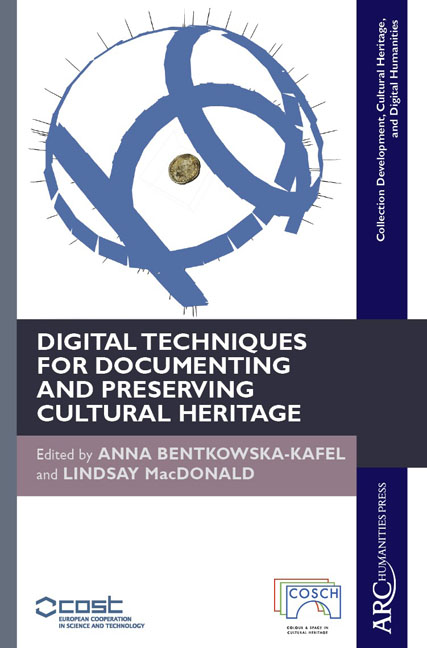Introduction
Published online by Cambridge University Press: 26 January 2021
Summary
This book presents some of the outcomes of interdisciplinary research and debates conducted by the participants in the international network, Colour and Space in Cultural Heritage (COSCH) between 2012 and 2016. The book adds to a large body of literature on the applications of digital technologies to the study and preservation of cultural heritage. So why was another book on the subject needed? In this introduction the rationale for the book, its scope, and methodology are explained.
Cultural Heritage
After a certain period of time, human cultural activities and their products acquire the status of cultural heritage. The International Council on Monuments and Sites (ICOMOS 2002, 21) defines cultural heritage broadly as “an expression of the ways of living developed by a community and passed on from generation to generation.” Some standard definitions of cultural heritage, both tangible and intangible, in the context of 3D documentation, have been collated by the consortium, 3D-COFORM (Arnold et al. 2009, 16‒19).
No single book can cover the variety and richness of cultural heritage, or the methods of its documentation. The limitations are inevitable. The COSCH network limited its interests to material objects of the cultural heritage of Europe, some of which are covered in this book. The objects and sites come from different periods and bear witness to different cultures. They vary in scale and materials, significance and value. They include an ancient Greek vase, the Karabournaki kantharos (chapter 2); Roman silver coins, the denarii of Faustina the Elder (chapter 3); painted wall decoration of the medieval French château of Germolles (chapter 4); a fortress overlooking Sarajevo, steeped in the multicultural, turbulent history of Bosnia (chapter 5); a medieval wooden shipwreck, known as a cog, lifted from a river bed in Germany (chapter 7); and a variety of historic objects housed by the National Museum of Romanian History, Bucharest, including icons, illuminated manuscripts, and pottery (chapter 6). Other works of world art and architecture, as significant as the ancient, rock-cut statues of Buddha in the Bamiyan Valley in Afghanistan, demolished by the Taliban in 2001, are mentioned in the second part of the book. This small selection is representative of other art, crafts, and architecture, in various states of preservation and restoration that can be found in situ or housed in museums.
- Type
- Chapter
- Information
- Digital Techniques for Documenting and Preserving Cultural Heritage , pp. xxxiii - xlivPublisher: Amsterdam University PressPrint publication year: 2018
- 1
- Cited by



